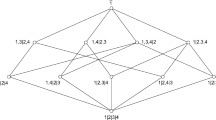Abstract
The equivalence problem is to determine the finest partition on a set that is consistent with a sequence of assertions of the form “x ≡ y”. A strategy for doing this on a computer processes the assertions serially, maintaining always in storage a representation of the partition defined by the assertions so far encountered. To process the command “x ≡ y”, the equivalence classes of x and y are determined. If they are the same, nothing further is done; otherwise the two classes are merged together.
Work reported herein was conducted at the Artificial Intelligence Laboratory, a Massachusetts Institute of Technology research program supported in part by the Advanced Research Projects Agency of the Department of Defense and monitored by the Office of Naval Research under Contract Number N00014-70-A-0362-0003.
Access this chapter
Tax calculation will be finalised at checkout
Purchases are for personal use only
Preview
Unable to display preview. Download preview PDF.
Similar content being viewed by others
Author information
Authors and Affiliations
Editor information
Editors and Affiliations
Rights and permissions
Copyright information
© 1972 Plenum Press, New York
About this chapter
Cite this chapter
Fischer, M.J. (1972). Efficiency of Equivalence Algorithms. In: Miller, R.E., Thatcher, J.W., Bohlinger, J.D. (eds) Complexity of Computer Computations. The IBM Research Symposia Series. Springer, Boston, MA. https://doi.org/10.1007/978-1-4684-2001-2_14
Download citation
DOI: https://doi.org/10.1007/978-1-4684-2001-2_14
Publisher Name: Springer, Boston, MA
Print ISBN: 978-1-4684-2003-6
Online ISBN: 978-1-4684-2001-2
eBook Packages: Springer Book Archive




